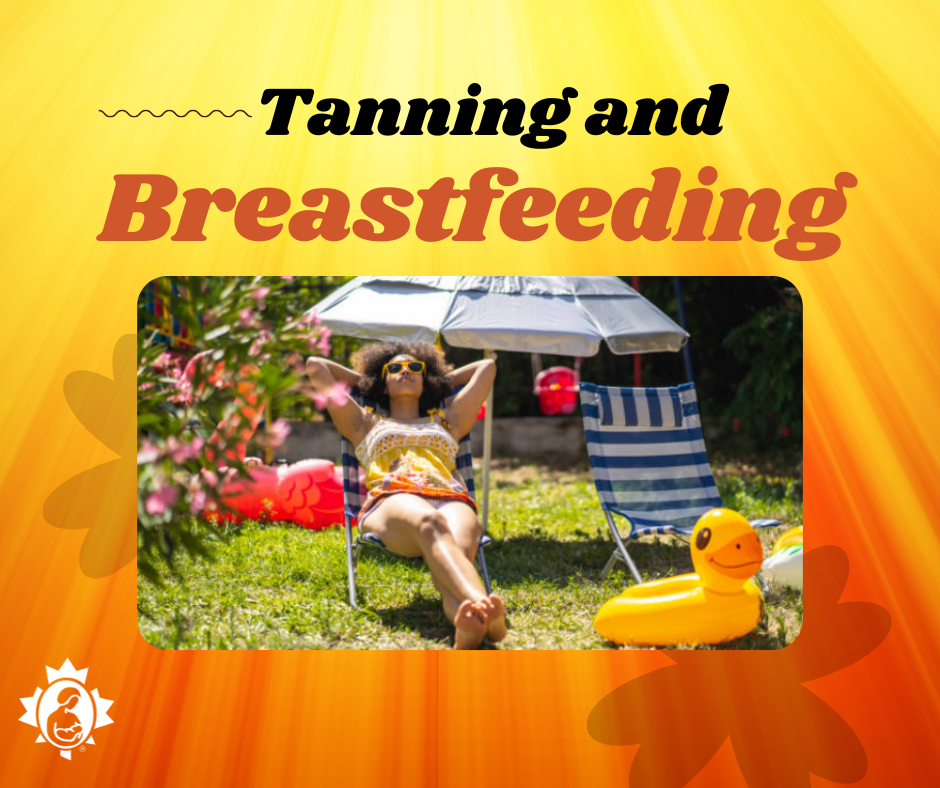
Tanning outdoors and indoors
Sun tanning outdoors is completely compatible with breastfeeding and will not alter your milk in any way. If you are sun tanning outside, keep your baby out of the sun because an infant’s skin is much more vulnerable to burning than adult skin. If you go to a tanning studio, you may be offered carotene to enhance the tanning. This should be avoided while breastfeeding. The body converts carotene to the fat-soluble, vitamin A which then passes into your milk. Although a sufficient amount of vitamin A in your milk is very important for your baby’s health, high concentrations can be harmful. You should not take a vitamin A supplement unless advised to do so by your health professional.
No matter which way you are tanning, it is always important to protect your nipples. You do not want to risk getting a burn on them. This would make nursing very uncomfortable. It’s also important to keep in mind that ultraviolet exposure of any kind ages skin prematurely and increases the risk of skin cancer.
Self-tanning lotions
The most common ingredient in commercial spray tans (also called UV-free tanning, airbrush tanning, and spray-on tanning) is dihydroxyacetone. This chemical is approved for external use in Canada. The current understanding is that this chemical does not penetrate the skin beyond the first few layers and is not absorbed into the bloodstream. If it is not absorbed into your bloodstream then it will not be present in your milk.
Dihydroxyacetone is not approved for internal use. Avoid using these products on your breasts and nipples so your baby does not accidentally ingest any. This will also ensure that your baby does not get any of this chemical on their very delicate skin during breastfeeding.
If you do accidentally get dihydroxyacetone on your breast, it can be washed off with soap and warm water, depending on how long it has been on the skin. There are no guarantees that washing will remove all traces of a spray tanning product. If you think your baby has been exposed to a spray tanning product through breastfeeding, contact your local poison control centre for advice.
Spray-on tanning products
Dihydroxyacetone is not approved for internal use. The concern with spray-on tanning products is the risk of this product being absorbed into the bloodstream either by breathing it in or by the product coming into contact with your body’s mucous membranes (for example: eyes, inside the nose and mouth). If this chemical is absorbed into your bloodstream it could, potentially, enter your milk. Therefore it is best to avoid the use of spray-on products while nursing. If you choose to use a spray-on product, wearing a mask during application may reduce the risk of inhalation. Consult with a health professional for more information on how to avoid these risks while breastfeeding.
Oral tanning products/tanning pills
Tanning pills contain colouring agents that are deposited in the fatty tissue under your skin to give the appearance of a tan. These products are not approved by Health Canada and should not be used while breastfeeding.
Please consider supporting LLLC.
References:
U.S. Food and Drug Administration. (2022, March 15). Sunless Tanners and Bronzers. fda.gov. https://www.fda.gov/cosmetics/cosmetic-products/sunless-tanners-bronzers
Health Canada. (2018, September 5). Tanning Products. canada.ca. https://www.canada.ca/en/health-canada/services/cosmetics/tanning-products.html
Healthline. (2016, June 16). Can You Take Vitamin A While Breastfeeding? https://www.healthline.com/health/breastfeeding/vitamin-a-breastfeeding
National Library of Medicine. (2022, June 20). Vitamin A. Drugs and Lactation Database (Lactmed). https://www.ncbi.nlm.nih.gov/books/NBK513060/
Updated 2024
